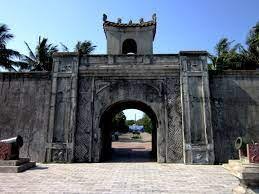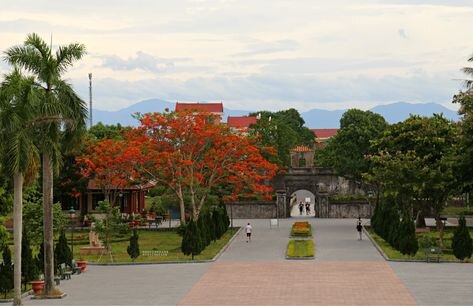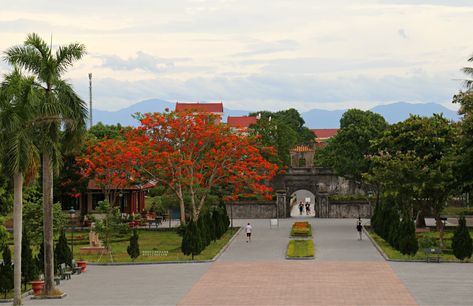Blog, Places to go, Things to explore
Quang Tri Ancient Citadel – 81-day fierce war
Quang Tri Ancient Citadel – a citadel located by the Thach Han River, known through the fierce 81-day battle to keep the citadel in the nation’s history. Today, the Citadel is an emotional attraction, this is considered a cemetery without graves, the common grave of the Citadel soldiers who fell for their homeland for the sake of peace and reunification.
Quang Tri Ancient Citadel under the Nguyen Dynasty

One of four gates
Quang Tri Ancient Citadel was built during the reign of King Gia Long and was completed in the reign of King Minh Mang, lasting for nearly 28 years (1809-1837), the citadel was initially covered with soil, until 1837 King Minh Mang rebuilt by brick. The Citadel is square in shape with a perimeter of 2160m long, 3m high wall, 13.5m thick at the foot, 0.72m thick at the top. Outside the citadel is a wide moat system surrounding it. The four corners of the citadel are four tall fortresses that protrude out. The citadel has 4 gates: Tien, Hau, Ta, Huu Xay, a rolling arch, 3.4m wide, with a gazebo, curved roof, tiled roof, all 4 doors are located in the middle of the 4 sides of the citadel.
Quang Tri Ancient Citadel under French colonial rule
During the period of French colonialism and domination, Quang Tri Citadel as the center of the local and provincial ruling apparatus. Quang Tri Citadel was chosen by the French army as one of the important bases of the military post system. France has built an additional prison system, expanded and solidified the prison to serve as a place to detain patriots and revolutionaries in the province and region. Quang Tri prison at one time became the leadership center of the revolutionary movement because it was the place where the core cores of the youth were kept, the first communist soldiers of Quang Tri and many leaders of the Communist Party of Vietnam. Provincial Party Committee, Country Party Committee belonged to the pre-insurrection period.
Quang Tri Ancient Citadel in the American – puppet period
The Geneva Agreement was signed on July 20, 1954, according to the agreement on the 17th parallel as the temporary dividing boundary. A part of Quang Tri from the Ben Hai River onward was liberated, and the districts from Gio Linh back to Hai Lang became a new colony of the American empire. Quang Tri town, including the ancient citadel of Quang Tri, became the political, military, economic and social center. The US – disguised the Ancient Citadel into a military zone, used it as a military treasure house and campaign command center for the whole province, and opened more prisons to suppress the revolutionary movement.
The Citadel in the 1972 strategic attack and the historic 81-day battle
The 1972 strategic offensive across the South began. On March 30, 1972, two Divisions 304 and 308 with the support of tank and artillery regiments crossed the demilitarized zone at the 17th line dividing the two regions. Simultaneously from the west, Division 324B with tank support along Route 9 from Laos passed Khe Sanh into Thach Han river valley. With the combined force of our troops, we surprised the puppet defenders and their American allies. Our troops attacked the defensive positions of the 3rd puppet division, disintegrating the enemy forces.
On April 28, we captured Dong Ha and approached Quang Tri town. On April 29, the puppet troops were ordered to withdraw to defend at My Chanh River.
On May 2, Quang Tri Town was liberated. The victory of the Quang Tri campaign in 1972 fundamentally changed the battlefield situation, pushing the US strategy of “Vietnamization of the war” to the brink of bankruptcy, creating momentum and replacing the complete liberation of the South. .
In order to lose Quang Tri, the Americans and puppets frantically launched a counterattack to retake Quang Tri with the codename “Lam Son 72”. In which, the number 1 goal is to capture the ancient citadel of Quang Tri. In the history of war, there has never been an operation where the main objective was to capture a citadel with a circumference of less than 2,000 meters, but the enemy mobilized a powerful force: with the support of the American fleet. , a series of B52 bombers, a huge amount of bombs and bullets like in the campaign to recapture Quang Tri Citadel. Quang Tri town in 81 days and nights from June 28 to September 16 is like a bomb bag. On average, each day the enemy mobilized 150-170 times of jet aircraft, 70-90 times of B52s to bomb the town and the ancient citadel of Quang Tri. With an area of less than 3 square kilometers, in 81 days and nights the town and Quang Tri Citadel suffered 328,000 tons of bombs and bullets, on average each of our soldiers had to bear 100 tons of bombs and 200 shells.
And even though they were full of wounds, they still fought tenaciously, determined not to leave the battlefield, fighting until their last breath, every time one fell down, another came instead. The People’s Army Newspaper published on August 9, 1972 wrote, “Every square meter of land that our soldiers won in the Quang Tri Ancient Citadel is really a square meter of blood”. According to statistics, 80% of our soldiers died due to the pressure of bombs and bullets, even though they were sitting in the tunnels, they also broke their noses and ears and sacrificed themselves.
Due to the enemy’s firepower was too strong, our outer line was gradually broken. From the beginning of September, a fierce battle took place in the heart of the town and the Quang Tri Citadel. We and the enemy fought each other for every house, street corner, and wall of the Ancient Citadel. The weather at this time is not favorable, tropical depressions continuously occur, the water of Thach Han river rises, the whole town is submerged in the sea. Taking advantage of that situation, the enemy increased their bombardment on our fortifications. Our soldiers both took turns slapping water against the flood of fortifications, while fighting the enemy, all day immersed in water, eating dry food, drinking cold water, so their health declined, and there were many casualties.
The entrenched Citadel of Quang Tri in the 81-day and night counter-offensive campaign, when a decisive solution to the Vietnam war was coming to an end at the Paris negotiating table, it really meant something. vital meaning for both sides. This is shown: we are determined to keep the citadel while the enemy tries to capture it at all costs, when public opinion in the country as well as in the world is turning to the Quang Tri Ancient Citadel hour by minute. The event that the enemy failed to achieve the goal of “planting the flag” on the Citadel before July 13, 1972, they set up a fake citadel in Tram Ly village (more than 2km from the Quang Tri Citadel), then filmed and took pictures. , announced the recapture of Quang Tri Citadel at the Paris Conference, is a testament to the importance of mastering Quang Tri Citadel in the decisive moment in 1972. When a solution is beneficial to us at The Paris Conference was basically decided, then keeping the Citadel was no longer meaningful, we decided to withdraw from the Citadel on the case of the North bank of the Thach Han River, although the price to pay for this event was quite high. Our force suffered a lot of casualties.
During those 81 days and nights to recapture the 16ha Quang Tri ancient citadel and the whole Quang Tri town over 3km2, the US dropped 328,000 tons of bombs here. The Western press at that time commented that it was equivalent to the destructive power of 7 American atomic bombs dropped on Hirosima Japan in 1945. Thus, 81 days and nights that entire town and this ancient citadel was razed. The Ancient Citadel has only traces of some sections of the citadel, the prison, the front gate, the back gate… From 1993 to 1995, the system of moats, bridges, culverts, some sections of the citadel and the front gate were repaired.
In the same 81 days and nights, thousands of soldiers who died here have not been able to get their remains because of the smoke, fire, bombs and bullets, their bones and blood were mixed into the rubble. That is why today at the center of the relic, a memorial is built to form a common grave for thousands of soldiers who fell in these fierce days and nights.
Quang Tri ancient citadel nowadays

Quang Tri ancient citadel
Today, Quang Tri ancient citadel is really a peaceful place for commemorating all the sacrifices of soldiers. As a part of DMZ tour from Hue, tourists will be able to recall how the war in 1972 unfolded. The museum in the citadel is also capturing a lot of remnants from the 81-day fierce war for you to discover.
Vietnamese source: (right here)

